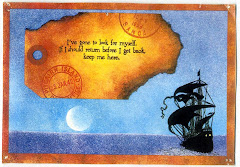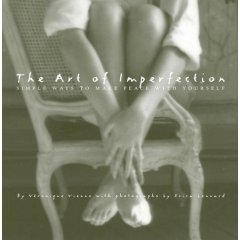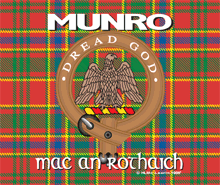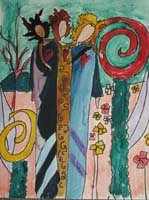"HARE'S 1st FULL MOON" by David Kettley
Those who think of the May Moon as the Flower Moon say that the flowers grow at night during this time, and even dance in honor of the moon. That is a wonderful image. However, of all the moon names, my favorite is Hare Moon, because of its association with the moon-gazing hare, of which there are a number of delightful paintings on the web.
Notice I said moon-gazing hare. Hares should never be confused with rabbits. They are entirely different species and are, except in physical resemblance, quite unalike. Baby rabbits (kittens) are born hairless, blind and helpless. Baby hares (leverets) are born fully-furred, can see and have independent movement. Hares are generally larger and have longer hind legs and longer ears with characteristic black markings. Only hares change color in the winter. Hares and rabbits have different diets. Rabbits are social creatures, while hares are mostly solitary creatures. Rabbits generally live underground in tunnels and burrows, but hares are always on the surface.
"MOON GAZING HARE" by Joanna May
The symbol of the moon-gazing hare is almost universal and dates back to ancient times. It symbolizes fertility. Pagans believed moon-gazing hares would bring growth, re-birth, abundance, new beginnings and fortune. To others, the hare symbolized purity, and a single hare was often used to signify the Virgin Mary's purity. This image of the hare, of course, is in sharp contrast to that of the fertile common rabbit.
In ancient Egyptian belief, hares were intrinsically linked to the moon's cyclical movement - being at once masculine when waxing and feminine when waning. Hares would thus be depicted as alchemists making the elixir of immortality or as messengers of the female moon deity.
I especially love the images directly above and below, because they shows a moon-gazy hare looking at an image of a hare on the moon! Since ancient times people have claimed to see the image of a rabbit or hare on the face of the moon. In East Asian culture, the Moon Rabbit or Jade Rabbit lives on the moon and is seen pounding a mortar and pestle. In Chinese folklore, the image is that of a companion to the Goddess Chang'e, who is pounding the elixir of life for her.
"LUNAR HARE" by Mandy Walden
http://www.mandywaldenartistprintmaker.co.uk/
http://www.mandywaldenartistprintmaker.co.uk/
In Buddhist lore, a monkey, an otter, a jackal, and a rabbit resolved to practice charity on the day of the full moon, believing a demonstration of great virtue would earn a great reward. When an old man begged for food, the monkey gathered fruits from the trees and the otter collected fish, while the jackal wrongfully pilfered a lizard and a pot of milk-curd.
The rabbit, who knew only how to gather grass, instead offered its own body, throwing itself into a fire the man had built. The rabbit, however, was not burned. The old man revealed himself to be Śakra, a Buddhist deity, and, touched by the rabbit's virtue, drew the likeness of the rabbit on the moon for all to see. It is said the lunar image is still draped in the smoke that rose when the rabbit cast itself into the fire. (In another version, the rabbit's companions are a fox and a monkey.)
"LUNA HARE" by Nicola Slattery
Similar hare/rabbit-on-the-moon legends occur in Mexican folklore. According to an Aztec legend, the god Quetzalcoatl, then living on Earth as a man, started on a journey and, after walking for a long time, became hungry and tired. With no food or water around, he thought he would die. Then a rabbit grazing nearby offered himself as food to save his life. Quetzalcoatl, moved by the rabbit's noble offering, elevated him to the moon, then lowered him back to Earth and told him, "You may be just a rabbit, but everyone will remember you; there is your image in light, for all men and for all times."
Another legend from the New World tells of the brave and noble sacrifice of Nanahuatzin during the creation of the fifth sun. Humble Nanahuatzin sacrificed himself in fire to become the new sun, but the wealthy god Tecciztecatl hesitated four times before he finally set himself alight to become the moon. Due to Tecciztecatl's cowardice, the gods felt that the moon should not be as bright as the sun, so one of the gods threw a rabbit at his face to diminish his light. It is also said that Tecciztecatl was in the form of a rabbit when he sacrificed himself to become the moon, casting his shadow there.
"GLASTONBURY HARE" by Christopher Fry
http://www.glastonburygalleries.com/
(If you look closely at the lower left side of
(If you look closely at the lower left side of
the painting, you will see Glastonbury Tor.)
A Native American (Cree) legend tells a different variation, about a young rabbit who wished to ride the moon. Only the crane was willing to take him. The trip stretched Crane's legs as the heavy rabbit held them tightly, leaving them as elongated as crane's legs are now. When they reached the moon Rabbit touched Crane's head with a bleeding paw, leaving the red mark cranes wear to this day. According to the legend, Rabbit still rides the moon.
As the moon waxes and wanes, the common view of the hare has also waxed and waned. Revered in ancient times, the hare was later regarded with contempt and suspicion in early Christianity. It was considered to be a shape-shifting creature serving the interests of witches, ready to tempt man into perdition.
As the moon waxes and wanes, the common view of the hare has also waxed and waned. Revered in ancient times, the hare was later regarded with contempt and suspicion in early Christianity. It was considered to be a shape-shifting creature serving the interests of witches, ready to tempt man into perdition.
"THREE HARES"© Sue Wookey
A very intriguing aspect of hare legend and lore is the ancient symbol of The Three Hares. In her blog, artist Sue Wookey writes that "No one knows the real origin or meaning of this strange symbol, but it is found all along the Silk Road from China to South West England where it can be seen on church roof bosses and in stained glass.
"The Three Hares chase each other around and share three ears (not six) so it's a bit of an optical illusion. It's one of the many symbols that contain a trinity, like the triskelion (the Isle of Man symbol) and the Celtic symbol of three interlocking spirals. The symbol could be connected to the lunar cycle. Or perhaps not. No one knows. I've put moons in the painting anyway because - to me - it represents the cyclical passing of time which both races by faster than we can catch it and repeats at one and the same time."
"The Three Hares chase each other around and share three ears (not six) so it's a bit of an optical illusion. It's one of the many symbols that contain a trinity, like the triskelion (the Isle of Man symbol) and the Celtic symbol of three interlocking spirals. The symbol could be connected to the lunar cycle. Or perhaps not. No one knows. I've put moons in the painting anyway because - to me - it represents the cyclical passing of time which both races by faster than we can catch it and repeats at one and the same time."
The quotes around the outside of the painting are: "In time take time while time doth last, for time is no time when time is past." (anonymous) and "The passing minute is every man's equal possession, but what has once gone by is not ours." (Marcus Aurelius).
According to The Three Hares project, which investigated the origin of this symbol, the image is "an extraordinary and ancient archetype, stretching across diverse religions, cultures, many centuries and many thousands of miles. It is part of the shared medieval heritage of Europe and Asia - of Buddhism, Islam and Judaism."
Wendy Andrew wrote and illustrated
this delightful book (print also available)
this delightful book (print also available)
~~~~~~~~~~
"FULL MOON RHYME"
~ by Judith Wright
~ by Judith Wright
There's a hare in the moon tonight
Crouching alone in the bright
buttercup field of the moon
and all the dogs in the world
howl at the hare in the moon.
"I chased that hare to the sky"
the hungry dogs cry.
"The hare jumped to the moon
and left me here in the cold.
I chased that hare to the moon.
Come down again, wild hare,
we can see you there"
we can see you there"
The dogs all howl to the moon.
"Come down again to the world,
you mad black hare in the moon
Or we will grow wings and fly
up to the star-grassed sky
to hunt you out of the moon"
The hungry dogs of the world
howl at the hare in the moon.
~~~~~~~~~~
NOTES:
The fantastic Stonewylde series of books, which I promote on my sidebar, features moon-gazing rabbits and also a moon-gazy girl, the heroine Sylvie. When the moon is full, Sylvie finds herself powerlessly drawn to follow the hares and dance herself into a trance beneath the shining orb.
**********
**********
I, myself, have never seen a hare on the moon. Every time I look at the full moon, I see the same old thing: The enigmatically smiling face of the Man in the Moon. If you wish to see some widely varying interpretations, just Google the words "hare" (or rabbit) on the moon". Maybe you'll find the hare you always see when you gaze up at the moon.





































12 comments:
I have seen the moon tonight, and it was full, reddish and so down to earth. The sight was extraterrestrial and I was smitten by the primitive magic of Life...
I had never seen the moon like that before. I did not know it is the May Full Moon. Thanks, Celtic Lady !
I've never seen a hare in the moon either. But I have enjoyed reading the various moon-gazing hare stories in your post today; and the graphics too. Thanks as always for wonderful info! Happy Full Moon!
Wonderful tales - and pictures - thank you.
fab post Julie! It was cloudy here last night so the moon was obscured sadly. i'll try again tonight
Leanne x
Fabulous post!
I shall enjoy following those links. Here In Glastonbury, there are many fabulous hares for sale in the shops, I have started a "hare fund" to save up for one!
Blessings Kath
If you're into hares, check this out. I have one and it's gorgeous.
http://www.goddessandgreenman.co.uk/shop/tarot_and_oracles/prod/moon_hare_oracle_by_hannah_willow/
I really enjoyed this blog.
I thank you for sharing such Magical stories.
Peace and Love
I saw a Giant King Hare on a full Moon on a open space lawn in Jamaica ! It was 5:30 am and I came out to the balcony and there was he.. 4ft tall giant hare , shiny silver with white inside ears shiny in moon light ! Loved It ! They are pretty rear - but know in Jamaica as Connies ;) one love
I am 40 years old and fixated on getting my first ever tattoo. I don't know if I'll actually go through with it, but the concept of the moon-gazing hare really speaks to me on so any levels. After reading these stories, I'm now convinced more than ever that this is THE one. My name is Dawn which also symbolizes new beginnings much like the hare. I, like the hare, enjoy my solitude and have always been fascinated with the moon throughout my entire life. I also see a neighborhood rabbit out at night ( possibly moon-gazing?) very frequently. I'm always alone when I see it. Yes, if I do get a tat, this is it. Thanks so much for sharing these wonderful stories.
I am 40 years old and fixated on getting my first ever tattoo. I don't know if I'll actually go through with it, but the concept of the moon-gazing hare really speaks to me on so any levels. After reading these stories, I'm now convinced more than ever that this is THE one. My name is Dawn which also symbolizes new beginnings much like the hare. I, like the hare, enjoy my solitude and have always been fascinated with the moon throughout my entire life. I also see a neighborhood rabbit out at night ( possibly moon-gazing?) very frequently. I'm always alone when I see it. Yes, if I do get a tat, this is it. Thanks so much for sharing these wonderful stories.
You may like - actually, I think you'll LOVE - an amazing English artist called Jackie Morris, who has drawn and painted hares, with and without the full moon. Have a look here: http://www.jackiemorris.co.uk/blog/book-list/song-of-the-golden-hare/
Post a Comment